oil level CHRYSLER VOYAGER 2022 Owners Manual
[x] Cancel search | Manufacturer: CHRYSLER, Model Year: 2022, Model line: VOYAGER, Model: CHRYSLER VOYAGER 2022Pages: 316, PDF Size: 17.41 MB
Page 7 of 316
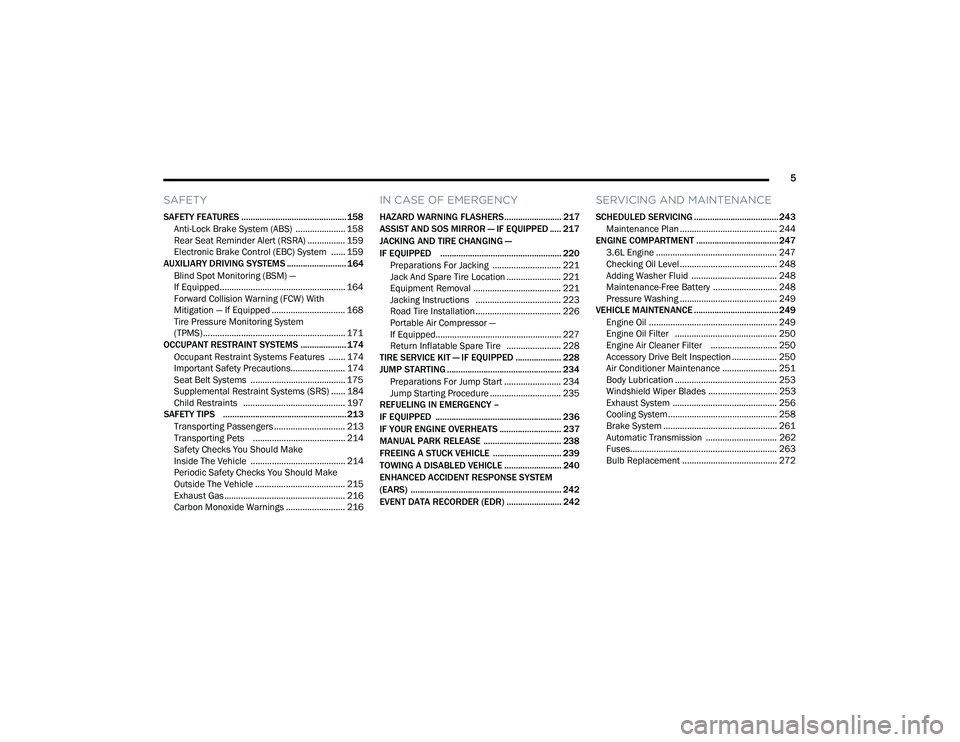
5
SAFETY
SAFETY FEATURES .............................................. 158Anti-Lock Brake System (ABS) ..................... 158
Rear Seat Reminder Alert (RSRA) ................ 159
Electronic Brake Control (EBC) System ...... 159
AUXILIARY DRIVING SYSTEMS .......................... 164
Blind Spot Monitoring (BSM) —
If Equipped..................................................... 164
Forward Collision Warning (FCW) With
Mitigation — If Equipped ............................... 168
Tire Pressure Monitoring System
(TPMS)............................................................ 171
OCCUPANT RESTRAINT SYSTEMS .................... 174
Occupant Restraint Systems Features ....... 174Important Safety Precautions....................... 174
Seat Belt Systems ........................................ 175
Supplemental Restraint Systems (SRS) ...... 184
Child Restraints ........................................... 197
SAFETY TIPS ......................................................213
Transporting Passengers .............................. 213Transporting Pets ....................................... 214
Safety Checks You Should Make
Inside The Vehicle ........................................ 214
Periodic Safety Checks You Should Make
Outside The Vehicle ...................................... 215Exhaust Gas ................................................... 216Carbon Monoxide Warnings ......................... 216
IN CASE OF EMERGENCY
HAZARD WARNING FLASHERS......................... 217
ASSIST AND SOS MIRROR — IF EQUIPPED ..... 217
JACKING AND TIRE CHANGING —
IF EQUIPPED ..................................................... 220 Preparations For Jacking ............................. 221
Jack And Spare Tire Location ....................... 221
Equipment Removal ..................................... 221
Jacking Instructions .................................... 223
Road Tire Installation .................................... 226
Portable Air Compressor —
If Equipped..................................................... 227Return Inflatable Spare Tire ....................... 228
TIRE SERVICE KIT — IF EQUIPPED .................... 228
JUMP STARTING .................................................. 234 Preparations For Jump Start ........................ 234
Jump Starting Procedure .............................. 235
REFUELING IN EMERGENCY –
IF EQUIPPED ....................................................... 236
IF YOUR ENGINE OVERHEATS ........................... 237
MANUAL PARK RELEASE .................................. 238
FREEING A STUCK VEHICLE .............................. 239
TOWING A DISABLED VEHICLE ......................... 240
ENHANCED ACCIDENT RESPONSE SYSTEM
(EARS) .................................................................. 242
EVENT DATA RECORDER (EDR) ........................ 242
SERVICING AND MAINTENANCE
SCHEDULED SERVICING ..................................... 243
Maintenance Plan ......................................... 244
ENGINE COMPARTMENT .................................... 247
3.6L Engine ................................................... 247
Checking Oil Level ......................................... 248
Adding Washer Fluid .................................... 248
Maintenance-Free Battery ........................... 248
Pressure Washing ......................................... 249
VEHICLE MAINTENANCE ..................................... 249
Engine Oil ...................................................... 249
Engine Oil Filter ........................................... 250
Engine Air Cleaner Filter ............................ 250
Accessory Drive Belt Inspection ................... 250Air Conditioner Maintenance ....................... 251
Body Lubrication ........................................... 253
Windshield Wiper Blades ............................. 253Exhaust System ............................................ 256
Cooling System.............................................. 258
Brake System ................................................ 261
Automatic Transmission .............................. 262
Fuses.............................................................. 263
Bulb Replacement ........................................ 272
22_RUVG_OM_EN_USC_t.book Page 5
Page 85 of 316
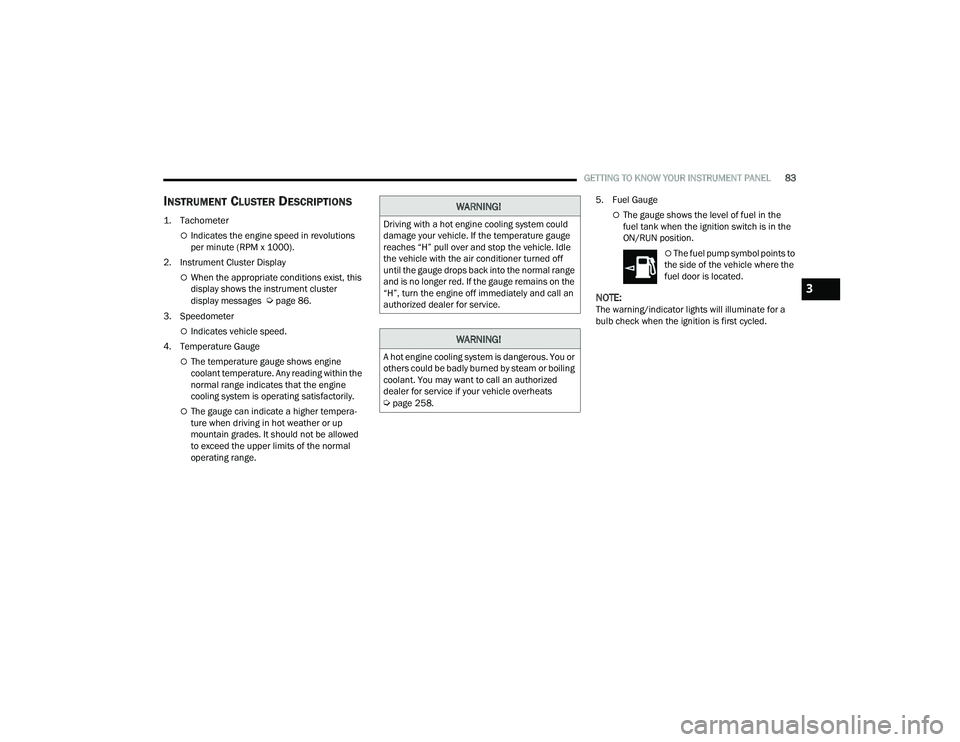
GETTING TO KNOW YOUR INSTRUMENT PANEL83
INSTRUMENT CLUSTER DESCRIPTIONS
1. Tachometer
Indicates the engine speed in revolutions
per minute (RPM x 1000).
2. Instrument Cluster Display
When the appropriate conditions exist, this
display shows the instrument cluster
display messages
Úpage 86.
3. Speedometer
Indicates vehicle speed.
4. Temperature Gauge
The temperature gauge shows engine
coolant temperature. Any reading within the
normal range indicates that the engine
cooling system is operating satisfactorily.
The gauge can indicate a higher tempera -
ture when driving in hot weather or up
mountain grades. It should not be allowed
to exceed the upper limits of the normal
operating range. 5. Fuel Gauge
The gauge shows the level of fuel in the
fuel tank when the ignition switch is in the
ON/RUN position.
The fuel pump symbol points to
the side of the vehicle where the
fuel door is located.
NOTE:The warning/indicator lights will illuminate for a
bulb check when the ignition is first cycled.
WARNING!
Driving with a hot engine cooling system could
damage your vehicle. If the temperature gauge
reaches “H” pull over and stop the vehicle. Idle
the vehicle with the air conditioner turned off
until the gauge drops back into the normal range
and is no longer red. If the gauge remains on the
“H”, turn the engine off immediately and call an
authorized dealer for service.
WARNING!
A hot engine cooling system is dangerous. You or
others could be badly burned by steam or boiling
coolant. You may want to call an authorized
dealer for service if your vehicle overheats
Úpage 258.
3
22_RUVG_OM_EN_USC_t.book Page 83
Page 87 of 316
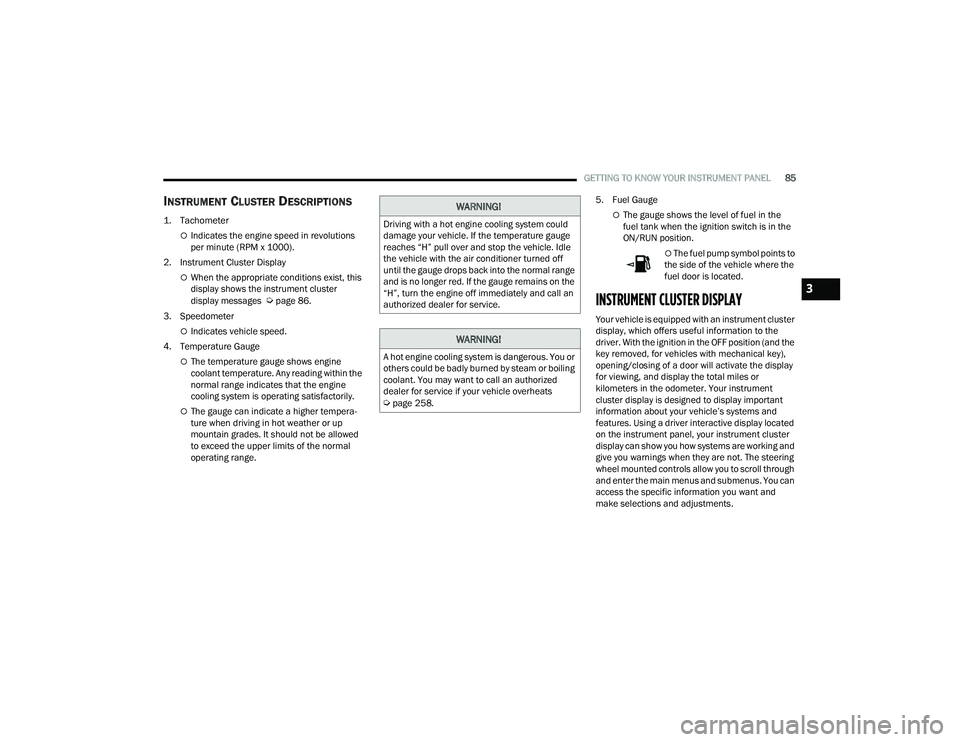
GETTING TO KNOW YOUR INSTRUMENT PANEL85
INSTRUMENT CLUSTER DESCRIPTIONS
1. Tachometer
Indicates the engine speed in revolutions
per minute (RPM x 1000).
2. Instrument Cluster Display
When the appropriate conditions exist, this
display shows the instrument cluster
display messages
Úpage 86.
3. Speedometer
Indicates vehicle speed.
4. Temperature Gauge
The temperature gauge shows engine
coolant temperature. Any reading within the
normal range indicates that the engine
cooling system is operating satisfactorily.
The gauge can indicate a higher tempera -
ture when driving in hot weather or up
mountain grades. It should not be allowed
to exceed the upper limits of the normal
operating range. 5. Fuel Gauge
The gauge shows the level of fuel in the
fuel tank when the ignition switch is in the
ON/RUN position.
The fuel pump symbol points to
the side of the vehicle where the
fuel door is located.
INSTRUMENT CLUSTER DISPLAY
Your vehicle is equipped with an instrument cluster
display, which offers useful information to the
driver. With the ignition in the OFF position (and the
key removed, for vehicles with mechanical key),
opening/closing of a door will activate the display
for viewing, and display the total miles or
kilometers in the odometer. Your instrument
cluster display is designed to display important
information about your vehicle’s systems and
features. Using a driver interactive display located
on the instrument panel, your instrument cluster
display can show you how systems are working and
give you warnings when they are not. The steering
wheel mounted controls allow you to scroll through
and enter the main menus and submenus. You can
access the specific information you want and
make selections and adjustments.
WARNING!
Driving with a hot engine cooling system could
damage your vehicle. If the temperature gauge
reaches “H” pull over and stop the vehicle. Idle
the vehicle with the air conditioner turned off
until the gauge drops back into the normal range
and is no longer red. If the gauge remains on the
“H”, turn the engine off immediately and call an
authorized dealer for service.
WARNING!
A hot engine cooling system is dangerous. You or
others could be badly burned by steam or boiling
coolant. You may want to call an authorized
dealer for service if your vehicle overheats
Úpage 258.
3
22_RUVG_OM_EN_USC_t.book Page 85
Page 99 of 316
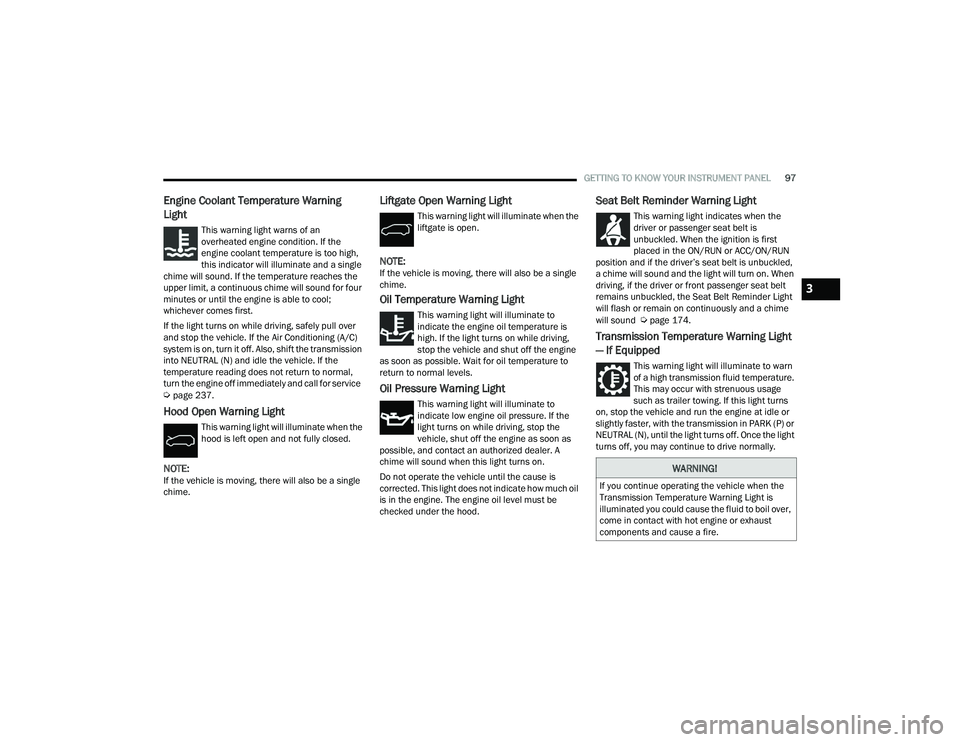
GETTING TO KNOW YOUR INSTRUMENT PANEL97
Engine Coolant Temperature Warning
Light
This warning light warns of an
overheated engine condition. If the
engine coolant temperature is too high,
this indicator will illuminate and a single
chime will sound. If the temperature reaches the
upper limit, a continuous chime will sound for four
minutes or until the engine is able to cool;
whichever comes first.
If the light turns on while driving, safely pull over
and stop the vehicle. If the Air Conditioning (A/C)
system is on, turn it off. Also, shift the transmission
into NEUTRAL (N) and idle the vehicle. If the
temperature reading does not return to normal,
turn the engine off immediately and call for service
Úpage 237.
Hood Open Warning Light
This warning light will illuminate when the
hood is left open and not fully closed.
NOTE:If the vehicle is moving, there will also be a single
chime.
Liftgate Open Warning Light
This warning light will illuminate when the
liftgate is open.
NOTE:If the vehicle is moving, there will also be a single
chime.
Oil Temperature Warning Light
This warning light will illuminate to
indicate the engine oil temperature is
high. If the light turns on while driving,
stop the vehicle and shut off the engine
as soon as possible. Wait for oil temperature to
return to normal levels.
Oil Pressure Warning Light
This warning light will illuminate to
indicate low engine oil pressure. If the
light turns on while driving, stop the
vehicle, shut off the engine as soon as
possible, and contact an authorized dealer. A
chime will sound when this light turns on.
Do not operate the vehicle until the cause is
corrected. This light does not indicate how much oil
is in the engine. The engine oil level must be
checked under the hood.
Seat Belt Reminder Warning Light
This warning light indicates when the
driver or passenger seat belt is
unbuckled. When the ignition is first
placed in the ON/RUN or ACC/ON/RUN
position and if the driver’s seat belt is unbuckled,
a chime will sound and the light will turn on. When
driving, if the driver or front passenger seat belt
remains unbuckled, the Seat Belt Reminder Light
will flash or remain on continuously and a chime
will sound
Úpage 174.
Transmission Temperature Warning Light
— If Equipped
This warning light will illuminate to warn
of a high transmission fluid temperature.
This may occur with strenuous usage
such as trailer towing. If this light turns
on, stop the vehicle and run the engine at idle or
slightly faster, with the transmission in PARK (P) or
NEUTRAL (N), until the light turns off. Once the light
turns off, you may continue to drive normally.
WARNING!
If you continue operating the vehicle when the
Transmission Temperature Warning Light is
illuminated you could cause the fluid to boil over,
come in contact with hot engine or exhaust
components and cause a fire.
3
22_RUVG_OM_EN_USC_t.book Page 97
Page 245 of 316
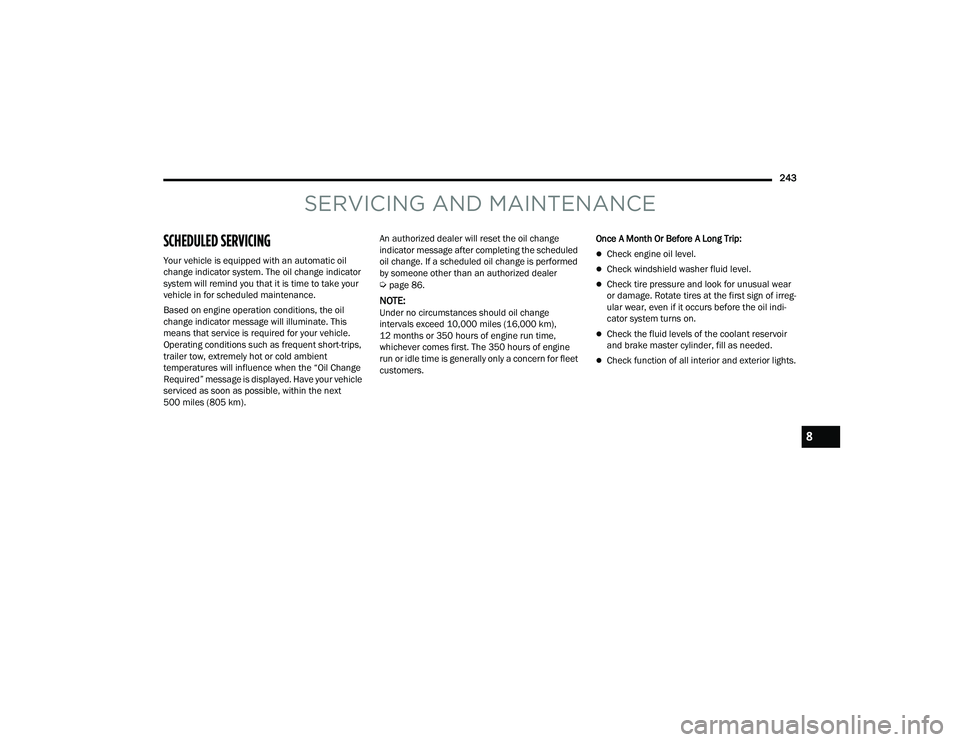
243
SERVICING AND MAINTENANCE
SCHEDULED SERVICING
Your vehicle is equipped with an automatic oil
change indicator system. The oil change indicator
system will remind you that it is time to take your
vehicle in for scheduled maintenance.
Based on engine operation conditions, the oil
change indicator message will illuminate. This
means that service is required for your vehicle.
Operating conditions such as frequent short-trips,
trailer tow, extremely hot or cold ambient
temperatures will influence when the “Oil Change
Required” message is displayed. Have your vehicle
serviced as soon as possible, within the next
500 miles (805 km).An authorized dealer will reset the oil change
indicator message after completing the scheduled
oil change. If a scheduled oil change is performed
by someone other than an authorized dealer
Úpage 86.
NOTE:Under no circumstances should oil change
intervals exceed 10,000 miles (16,000 km),
12 months or 350 hours of engine run time,
whichever comes first. The 350 hours of engine
run or idle time is generally only a concern for fleet
customers.
Once A Month Or Before A Long Trip:
Check engine oil level.
Check windshield washer fluid level.
Check tire pressure and look for unusual wear
or damage. Rotate tires at the first sign of irreg
-
ular wear, even if it occurs before the oil indi -
cator system turns on.
Check the fluid levels of the coolant reservoir
and brake master cylinder, fill as needed.
Check function of all interior and exterior lights.
8
22_RUVG_OM_EN_USC_t.book Page 243
Page 250 of 316

248SERVICING AND MAINTENANCE
CHECKING OIL LEVEL
To ensure proper engine lubrication, the engine oil
must be maintained at the correct level. Check the
oil level at regular intervals, such as every fuel
stop. The best time to check the engine oil level is
about five minutes after a fully warmed up engine
is shut off.
Checking the oil while the vehicle is on level ground
will improve the accuracy of the oil level readings.
There are four possible dipstick types:
Crosshatched zone.
Crosshatched zone marked SAFE.
Crosshatched zone marked with MIN at the low
end of the range and MAX at the high end of the
range.
Crosshatched zone marked with dimples at the
MIN and the MAX ends of the range.
NOTE:Always maintain the oil level within the crosshatch
markings on the dipstick.
Adding 1 quart (1 liter) of oil when the reading is at
the low end of the dipstick range will raise the oil
level to the high end of the range marking.
ADDING WASHER FLUID
The fluid reservoir is located in the front of the
engine compartment. Be sure to check the fluid
level in the reservoir at regular intervals. Fill the
reservoir with windshield washer solvent (not
radiator antifreeze) and operate the system for a
few seconds to flush out the residual washer fluid.
When refilling the washer fluid reservoir, take
some washer fluid, apply it to a cloth or towel, and
wipe clean the wiper blades; this will help blade
performance.
To prevent freeze-up of your windshield washer
system in cold weather, select a solution or mixture
that meets or exceeds the temperature range of
your climate. This rating information can be found
on most washer fluid containers.
MAINTENANCE-FREE BATTERY
Your vehicle is equipped with a maintenance-free
battery. You will never have to add water, and
periodic maintenance is not required.
CAUTION!
Overfilling or underfilling the crankcase will
cause aeration or loss of oil pressure. This could
damage your engine.
WARNING!
Commercially available windshield washer
solvents are flammable. They could ignite and
burn you. Care must be exercised when filling or
working around the washer solution.
WARNING!
Battery fluid is a corrosive acid solution and
can burn or even blind you. Do not allow
battery fluid to contact your eyes, skin, or
clothing. Do not lean over a battery when
attaching clamps. If acid splashes in eyes or
on skin, flush the area immediately with large
amounts of water
Úpage 234.
Battery gas is flammable and explosive. Keep
flame or sparks away from the battery. Do not
use a booster battery or any other booster
source with an output greater than 12 Volts.
Do not allow cable clamps to touch each
other.
Battery posts, terminals, and related accesso -
ries contain lead and lead compounds. Wash
hands after handling.
22_RUVG_OM_EN_USC_t.book Page 248
Page 263 of 316

SERVICING AND MAINTENANCE261
(Continued)
BRAKE SYSTEM
In order to ensure brake system performance, all
brake system components should be inspected
periodically. For the proper maintenance intervals
Úpage 244.
Brake Master Cylinder
The fluid in the master cylinder should be checked
when performing under hood services or
immediately if the “Brake Warning Light” is
illuminated. Be sure to clean the top of the master cylinder area
before removing the cap. If necessary, add fluid to
bring the fluid level up to the requirements
described on the brake fluid reservoir. With disc
brakes, fluid level can be expected to fall as the
brake pads wear. Brake fluid level should be
checked when pads are replaced. However, low
fluid level may be caused by a leak and a checkup
may be needed.
Use only manufacturer recommended brake fluid
Úpage 300.
WARNING!
Riding the brakes can lead to brake failure and
possibly a collision. Driving with your foot resting
or riding on the brake pedal can result in
abnormally high brake temperatures, excessive
lining wear, and possible brake damage. You
would not have your full braking capacity in an
emergency.
WARNING!
Use only manufacturer recommended brake
fluid Úpage 300. Using the wrong type of
brake fluid can severely damage your brake
system and/or impair its performance. The
proper type of brake fluid for your vehicle is
also identified on the original factory installed
hydraulic master cylinder reservoir.
To avoid contamination from foreign matter or
moisture, use only new brake fluid or fluid that
has been in a tightly closed container. Keep
the master cylinder reservoir cap secured at
all times. Brake fluid in a open container
absorbs moisture from the air resulting in a
lower boiling point. This may cause it to boil
unexpectedly during hard or prolonged
braking, resulting in sudden brake failure. This
could result in a collision.
Overfilling the brake fluid reservoir can result
in spilling brake fluid on hot engine parts,
causing the brake fluid to catch fire. Brake
fluid can also damage painted and vinyl
surfaces, care should be taken to avoid its
contact with these surfaces.
Do not allow petroleum-based fluid to contam -
inate the brake fluid. Brake seal components
could be damaged, causing partial or
complete brake failure. This could result in a
collision.
WARNING!
8
22_RUVG_OM_EN_USC_t.book Page 261
Page 301 of 316
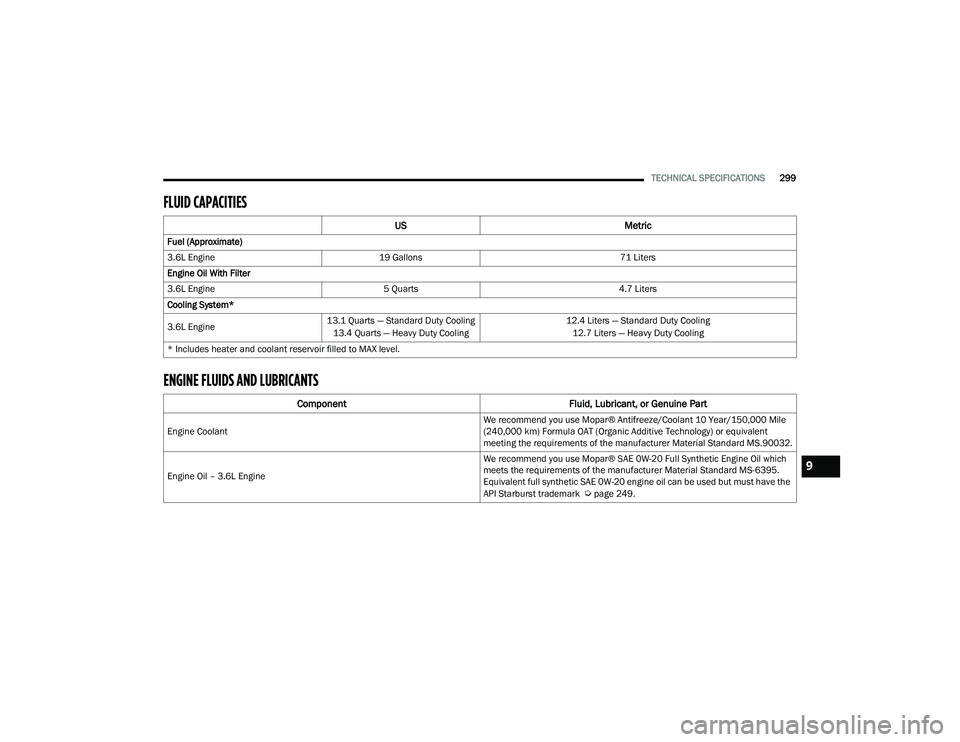
TECHNICAL SPECIFICATIONS299
FLUID CAPACITIES
ENGINE FLUIDS AND LUBRICANTS
US Metric
Fuel (Approximate)
3.6L Engine19 Gallons 71 Liters
Engine Oil With Filter
3.6L Engine 5 Quarts 4.7 Liters
Cooling System*
3.6L Engine 13.1 Quarts — Standard Duty Cooling
13.4 Quarts — Heavy Duty Cooling 12.4 Liters — Standard Duty Cooling
12.7 Liters — Heavy Duty Cooling
* Includes heater and coolant reservoir filled to MAX level.
Component Fluid, Lubricant, or Genuine Part
Engine Coolant We recommend you use Mopar® Antifreeze/Coolant 10 Year/150,000 Mile
(240,000 km) Formula OAT (Organic Additive Technology) or equivalent
meeting the requirements of the manufacturer Material Standard MS.90032.
Engine Oil – 3.6L Engine We recommend you use Mopar® SAE 0W-20 Full Synthetic Engine Oil which
meets the requirements of the manufacturer Material Standard MS-6395.
Equivalent full synthetic SAE 0W-20 engine oil can be used but must have the
API Starburst trademark
Úpage 249.
9
22_RUVG_OM_EN_USC_t.book Page 299
Page 308 of 316
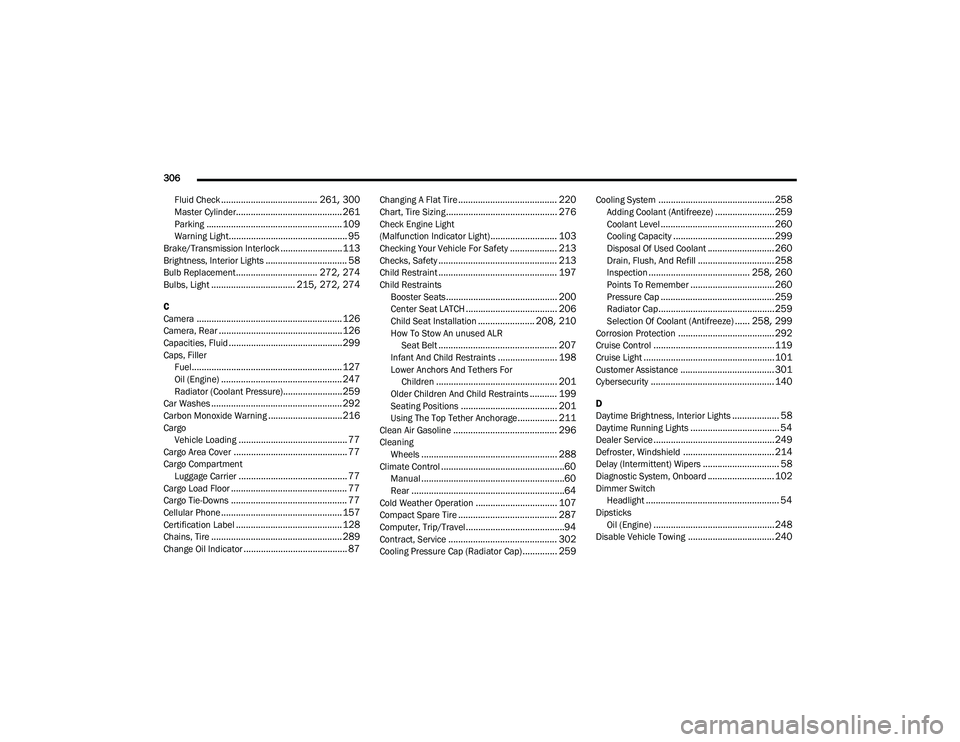
306
Fluid Check
....................................... 261, 300Master Cylinder........................................... 261Parking....................................................... 109Warning Light................................................ 95Brake/Transmission Interlock.........................113Brightness, Interior Lights................................. 58Bulb Replacement................................. 272, 274Bulbs, Light.................................. 215, 272, 274
C
Camera........................................................... 126Camera, Rear..................................................126Capacities, Fluid..............................................299Caps, Filler Fuel.............................................................127Oil (Engine)................................................. 247Radiator (Coolant Pressure)........................259Car Washes..................................................... 292Carbon Monoxide Warning..............................216CargoVehicle Loading
............................................ 77Cargo Area Cover.............................................. 77Cargo CompartmentLuggage Carrier............................................ 77Cargo Load Floor............................................... 77Cargo Tie-Downs............................................... 77Cellular Phone................................................. 157Certification Label........................................... 128Chains, Tire..................................................... 289Change Oil Indicator.......................................... 87
Changing A Flat Tire........................................ 220Chart, Tire Sizing............................................. 276Check Engine Light
(Malfunction Indicator Light)........................... 103Checking Your Vehicle For Safety................... 213Checks, Safety................................................ 213Child Restraint................................................ 197Child RestraintsBooster Seats............................................. 200Center Seat LATCH..................................... 206Child Seat Installation....................... 208, 210How To Stow An unused ALR Seat Belt................................................ 207Infant And Child Restraints........................ 198Lower Anchors And Tethers For Children................................................. 201Older Children And Child Restraints........... 199Seating Positions....................................... 201Using The Top Tether Anchorage................ 211Clean Air Gasoline.......................................... 296CleaningWheels....................................................... 288Climate Control..................................................60Manual..........................................................60Rear..............................................................64Cold Weather Operation................................. 107Compact Spare Tire........................................ 287Computer, Trip/Travel........................................94Contract, Service............................................ 302Cooling Pressure Cap (Radiator Cap).............. 259
Cooling System...............................................258Adding Coolant (Antifreeze)........................259Coolant Level.............................................. 260Cooling Capacity.........................................299Disposal Of Used Coolant........................... 260Drain, Flush, And Refill............................... 258Inspection......................................... 258, 260Points To Remember..................................260Pressure Cap.............................................. 259Radiator Cap...............................................259Selection Of Coolant (Antifreeze)...... 258, 299Corrosion Protection.......................................292Cruise Control.................................................119Cruise Light.....................................................101Customer Assistance...................................... 301Cybersecurity.................................................. 140
D
Daytime Brightness, Interior Lights................... 58Daytime Running Lights.................................... 54
Dealer Service.................................................249Defroster, Windshield.....................................214Delay (Intermittent) Wipers............................... 58Diagnostic System, Onboard........................... 102Dimmer SwitchHeadlight...................................................... 54DipsticksOil (Engine).................................................248Disable Vehicle Towing...................................240
22_RUVG_OM_EN_USC_t.book Page 306
Page 309 of 316
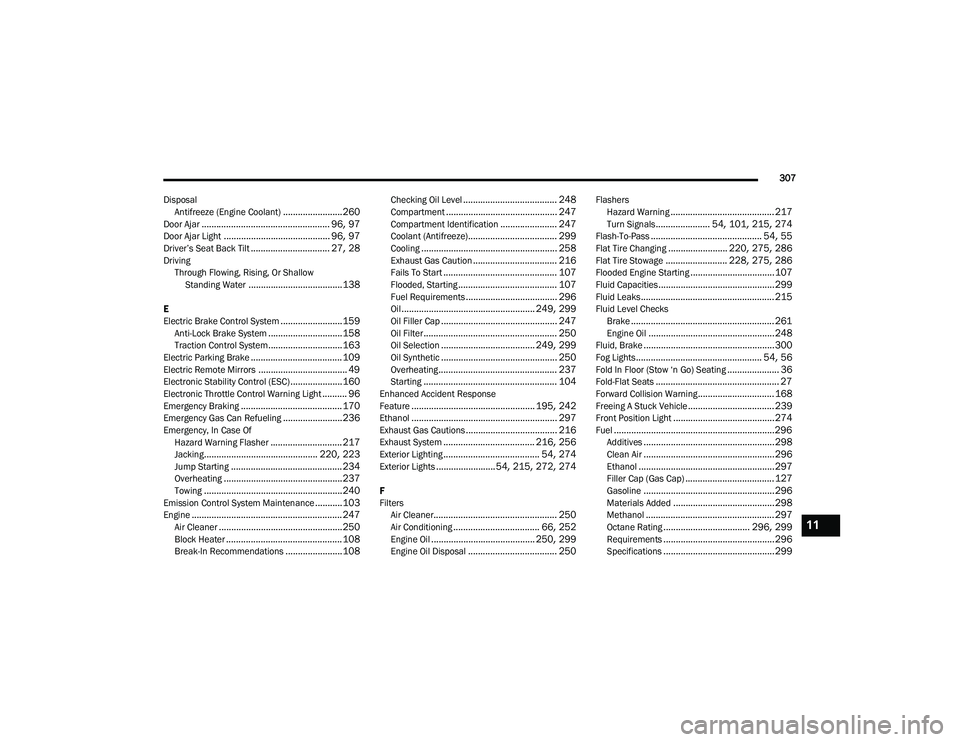
307
Disposal Antifreeze (Engine Coolant)
........................260Door Ajar.................................................... 96, 97Door Ajar Light........................................... 96, 97Driver’s Seat Back Tilt................................ 27, 28DrivingThrough Flowing, Rising, Or Shallow Standing Water
......................................138
E
Electric Brake Control System.........................159Anti-Lock Brake System..............................158Traction Control System..............................163Electric Parking Brake..................................... 109Electric Remote Mirrors.................................... 49Electronic Stability Control (ESC).....................160Electronic Throttle Control Warning Light.......... 96Emergency Braking......................................... 170Emergency Gas Can Refueling........................236Emergency, In Case OfHazard Warning Flasher............................. 217Jacking.............................................. 220, 223Jump Starting............................................. 234Overheating................................................237Towing........................................................240Emission Control System Maintenance...........103Engine.............................................................247Air Cleaner..................................................250Block Heater............................................... 108Break-In Recommendations.......................108
Checking Oil Level...................................... 248Compartment............................................. 247Compartment Identification....................... 247Coolant (Antifreeze).................................... 299Cooling....................................................... 258Exhaust Gas Caution.................................. 216Fails To Start.............................................. 107Flooded, Starting........................................ 107Fuel Requirements..................................... 296Oil...................................................... 249, 299Oil Filler Cap............................................... 247Oil Filter...................................................... 250Oil Selection...................................... 249, 299Oil Synthetic............................................... 250Overheating................................................ 237Starting...................................................... 104Enhanced Accident Response
Feature.................................................. 195, 242Ethanol........................................................... 297Exhaust Gas Cautions..................................... 216Exhaust System..................................... 216, 256Exterior Lighting....................................... 54, 274Exterior Lights........................ 54, 215, 272, 274
F
FiltersAir Cleaner
.................................................. 250Air Conditioning................................... 66, 252Engine Oil.......................................... 250, 299Engine Oil Disposal.................................... 250
FlashersHazard Warning.......................................... 217Turn Signals...................... 54, 101, 215, 274Flash-To-Pass............................................. 54, 55Flat Tire Changing........................ 220, 275, 286Flat Tire Stowage......................... 228, 275, 286Flooded Engine Starting..................................107Fluid Capacities...............................................299Fluid Leaks...................................................... 215Fluid Level ChecksBrake.......................................................... 261Engine Oil...................................................248Fluid, Brake.....................................................300Fog Lights................................................... 54, 56Fold In Floor (Stow ‘n Go) Seating..................... 36Fold-Flat Seats.................................................. 27Forward Collision Warning............................... 168Freeing A Stuck Vehicle...................................239Front Position Light.........................................274Fuel.................................................................296Additives.....................................................298Clean Air.....................................................296Ethanol.......................................................297Filler Cap (Gas Cap).................................... 127Gasoline.....................................................296Materials Added.........................................298Methanol.................................................... 297Octane Rating................................... 296, 299Requirements.............................................296Specifications.............................................299
11
22_RUVG_OM_EN_USC_t.book Page 307